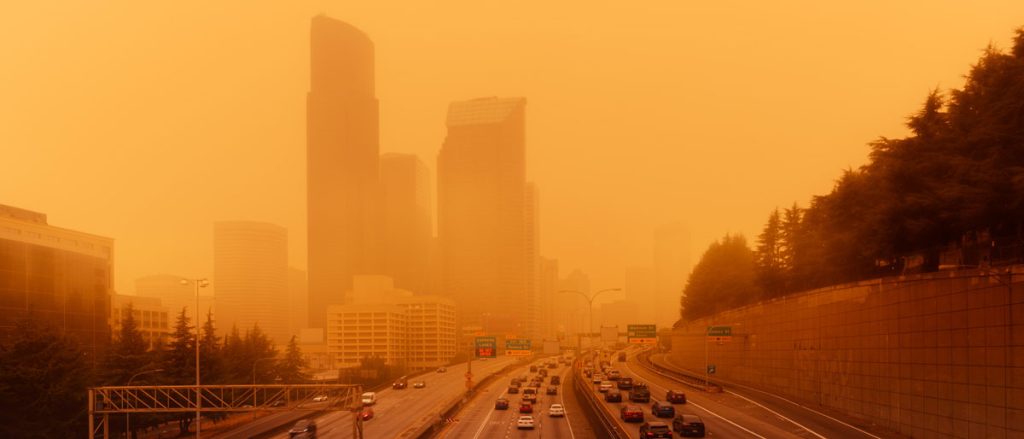The following is an excerpt from the GAWDA Safety Organizer, a monthly bulletin sent to GAWDA members. For more information on the GAWDA Safety Organizer, or to read past issues, visit the GAWDA.org Members-Only Section.
Due to the ongoing smoke pollution from the Canadian wildfires employees that work outside – especially drivers and yard employees- could be adversely affected by the smoke.
Member companies in the smoke path should review the NIOSH document below (or visit GAWDA.org to download a copy), consider training the employees on the contents of the document and supply N95 respirator masks to affected employees.
Wildfire Smoke and Outdoor Work
What is Wildfire Smoke?
Wildfire smoke is a complex mixture of gases and particles from burning vegetation and other materials. As a wildfire burns, different compounds are released in the smoke, such as carbon monoxide, carbon dioxide, hydrocarbons, particulate matter (PM), benzene, acrolein, and aldehydes. While exposure to wildfire smoke has been of interest to researchers and public health professionals for decades, it continues to be one of the least understood hazards of wildland fires. This is primarily due to the complexity of wildfire smoke, as the smoke is made up of many different types and amounts of potentially toxic compounds and can change very quickly depending on factors in the wildfire environment, such as weather, fire behavior, and the type of vegetation burning. Because of this, workers may be exposed to varying types and amounts of compounds in wildfire smoke throughout their work shift or during different fire events.
Can Wildfire Smoke Affect an Outdoor Worker’s Health?
There is very limited information about how exposure to wildfire smoke impacts outdoor workers. However, taken together with research studies examining exposure to smoke from wildland fires among the general public, along with assessments of the health effects of exposures to specific components of wildfire smoke, there is clear potential for such exposures to result in adverse health outcomes. The risk of experiencing symptoms and adverse health effects due to smoke exposure varies from person to person. Workers can have different individual risk factors such as age and health conditions (e.g., pre-existing heart or lung disease) that make them more likely to be affected by wildfire smoke. Some health effects known or suspected to be caused by wildfire smoke include:
- Symptoms such as eye irritation, sore throat, wheeze, and cough,
- Asthma and chronic obstructive pulmonary disease (COPD) exacerbations,
- Bronchitis and pneumonia,
- Adverse birth outcomes, and
- Cardiovascular (heart and blood vessel) outcomes.
Workers may also experience varying health effects when exposed to smoke. Long work schedules and physical demands of the work performed (resulting in higher breathing rates) may impact a worker’s exposures and health response to wildfire smoke. Still, the scientific community does not fully understand how long-term, repeated exposures, or exposures to high concentrations of wildfire smoke may affect a worker’s health. Additionally, very little is known about how exposure to many different compounds at the same time, including compounds released from the burning of man-made materials (such as those found in the wildland-urban interface), may affect a worker’s health. Employers should be aware that wildfire smoke may adversely affect the health of their workforce and prepare to take action to limit their workers’ exposures when a wildfire is emitting smoke in and around their work environment.
What Can Employers and Workers do to Reduce Smoke Exposure?
Employers and workers should prepare for and plan to implement procedures to reduce exposure to smoke when necessary. If workers must work in areas with high levels of smoke, especially for long periods, or if a worker is sensitive to wildfire smoke and feels their health or safety is negatively impacted by smoke exposure, the following steps can be implemented to reduce smoke exposure:
- Frequently monitor air quality conditions in the area by visiting the Environmental Protection Agency (EPA) U.S. Fire and Smoke Map or the state health department’s air quality website. This map provides the Air Quality Index (AQI) for a specific location and provides a range of air quality from good to hazardous. The AQI is EPA’s color-coded tool for communicating air quality to the public.
- Relocate or reschedule work tasks to smoke-free or less smoky areas or times of the day,
- Reduce levels of physical activity when possible, especially strenuous and heavy work,
- Require and encourage workers to take frequent breaks in places that are free from smoke, and
- Limit the worker’s smoke exposure by making accommodations for that worker to perform his/her duties indoors or in a location that reduces exposure to smoke, if possible. To create an indoor environment that reduces exposure to and protects the occupants from wildfire smoke, it is important that employers and building managers:
- Install air cleaners equipped with a high-efficiency particulate air (HEPA) filter or electrostatic precipitators,
- Ensure that windows and other building openings such as loading docks and bays are kept closed to reduce overall smoke exposure inside,
- Operate heating, ventilation, and air conditioning (HVAC) systems in the re-circulate setting or temporarily reduce the amount of outdoor air supplied to the building, and
- Install the highest efficiency filters recommended by the designer or manufacturer of the HVAC system.
Is Personal Protective Equipment (PPE) Such as Respirators an Option for Protecting Workers?
Controlling exposures to occupational hazards is the fundamental method of protecting workers. NIOSH recommends using the hierarchy of controls to determine how to implement feasible and effective workplace hazard control solutions. While elimination, substitution, and engineering and administrative controls are most effective in reducing workplace hazards, in some situations the use of personal protective equipment (PPE), such as the use of respirators, may be considered to limit a worker’s exposure to a hazard in the workplace. A NIOSH Approved filtering facepiece respirator (FFR), like an N95 respirator, can be used to reduce exposure to airborne particulates from wildfire smoke when the recommendations listed above cannot be implemented and it is feasible to obtain respirators. It is important to understand that FFRs do not protect against gases, such as carbon monoxide.
If an employer requires their employees to use respiratory protection to limit smoke exposure in an occupational setting, they must always do it as part of a comprehensive respiratory protection program as required under the Occupational Safety and Health Administration’s (OSHA) Respiratory Protection standard (29 CFR 1910.134). This includes medical evaluations, respirator fit testing, and training of the workers required to wear respirators. Additionally, when required in the occupational setting, tight-fitting respirators cannot be used by people with facial hair that interferes with the face seal.
When respirators are used on a voluntary basis in an occupational setting, employers should follow the requirements for the voluntary use of respirators. This information can be found on the OSHA website.
Respirators, such as an N95, may be one of the easiest controls to implement for limiting a worker’s exposure to the particulate matter in wildland smoke, and in some cases may be the only option to protect some workers. Employers, however, may need to consider alternative controls and solutions when respirators are not easily available.
What Actions are States Taking to Protect Outdoor Workers?
On July 29, 2019, the California Occupational Safety and Health Standards Board adopted an emergency regulation, Protection from Wildfire Smoke, designed to protect outdoor workers from wildfire smoke. This regulation applies to California workplaces where the Air Quality Index is greater than 151 for fine particulate matter (PM) from wildfire smoke or if it is anticipated that employees will be exposed to wildfire smoke. The AQI for a specific location can be found on the EPA US Fire and Smoke Map. More information about this emergency regulation and updates on a permanent standard can be found on the Cal/OSHA website.
When Working in Smoke, Consider
Preparing and planning for how to best implement the recommendations above in the workplace is critical. This is especially true in areas where wildfire smoke exposure is common, and workers are required to perform their jobs even when the air quality is considered unhealthy or even hazardous. Working together, employers and workers can take steps to reduce workers’ exposures to wildfire smoke.







